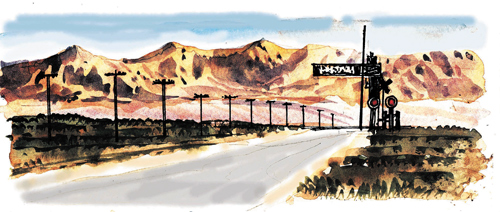Visit to California town like stepping into the past

California visitors headed for recreation at Lake Mead, Lake Mojave, the Colorado River and Laughlin often bypass the bright lights and heavy traffic of the Las Vegas area. Ten miles south of Primm near the California-Nevada Line, they exit Interstate 15 on the "Searchlight Cutoff," Highway 164. This two-lane alternative road follows a historic and scenic high desert route through tiny Nipton, Calif., to U.S. 95 at Searchlight, an early 1900s mining boomtown. This byway lies just 53 miles south of Las Vegas.
Nine miles east of the freeway exit, Nipton straddles the highway on the eastern side of the Union Pacific Railroad tracks. Originally called Nippeno after a nearby gold mine, Nipton grew at a crossroads of two overland roads in the late 1800s. Highway 164 follows the approximate route of the early wagon and stage route to the mines near Searchlight and the steamboat landing on the river near today’s Cottonwood Cove. The other road ran between the mines around Goodsprings to a Santa Fe Railroad siding at Goffs.
When Montana Sen. William Clark pushed his Salt Lake City-to-Los Angeles railroad through the Mojave Desert in the early 1900s, Nipton prospered as one of the railroad’s way stations and watering sites for the steam locomotives. The line later became part of the Union Pacific. Folks scattered across the Mojave picked up mail and got on or off the trains there. Equipment and goods came in and ore and cattle went out.
When the need for some place to stay became apparent, the Hotel Nipton arose beside the tracks. Constructed of adobe between 1904 and 1910, the small Spanish Territorial-styled hotel provided modest accommodations for more than 20 years. Thick adobe walls and a roofed veranda gave a measure of relief from the desert heat. The Whistle Stop Cafe next door provided meals. Movie-stars-turned-ranchers Clara Bow and husband, Rex Bell, frequented the hotel and picked up guests there for the trip to their Walking Box Ranch 16 miles away.
When railroads changed from steam to diesel locomotives, watering places such as Nipton became obsolete. Nipton seemed doomed after the trains no longer stopped. About the same time, the nearby mines began to play out. Nipton languished and dwindled for several decades under several owners until an energetic couple purchased the whole decrepit town in the mid-1980s. They began resuscitating the ghost town to make it attractive to tourists.
Today, visitors find a refurbished 1940s general store that stocks camping goods, snacks, souvenirs, gifts and books and dispenses information about the neighboring Mojave National Preserve. The restored Hotel Nipton welcomes guests as a bed and breakfast with five rooms and a central sitting room. Nipton’s visitors also stay overnight or longer in an RV park, four large tent cabins and two restored original dwellings. For rates and reservations, call (760) 856-2335.
The Whistle Stop Cafe serves lunch and dinner regularly and breakfast for overnighters. Guests should not expect resort-style accommodations or service, but they will find desert serenity (except when the trains pass by), star-spangled night skies and access to nearby recreation areas.
The highway continues past Nipton to climb into higher desert. If our early winter rains encourage wildflowers this spring, the flower show along this road should begin by March and continue into May. Early predictions are hopeful, but conditions for a good flower season are always dependent upon many elements. They will appear first on south-facing slopes. Hillsides, washes, sandy areas and rocky outcroppings all provide different habitats where different plants predominate. Park safely and walk to see blossoms concealed by vegetation.
Searchlight lies about a half-hour’s drive from Nipton. Stop for an introduction to early Searchlight history at the combination community center, library and indoor-outdoor museum east of U.S. 95 on the extension of Highway 164. Visitors driving from there down to Cottonwood Cove may find desert wildflowers appearing earlier than in the higher elevations between Nipton and Searchlight.
Margo Bartlett Pesek’s column appears on Sundays.